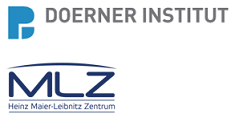Speaker
Description
The field of Cultural Heritage (CH) comprises many rare, valuable, and fragile samples. For this very reason, non-invasive and non-destructive techniques are the most preferred for their analysis. Among these techniques, XRF allows a fast elemental characterization of the artifacts, detecting a high range of elements. XRF also allows quantitative analysis, which is more feasible and reliable if the samples are of infinite thickness for the considered radiation, homogenous, and flat. Unfortunately, many samples related to the CH field are inhomogeneous, often presenting a layered structure. Indeed, they may have been created as a series of layers (like painting, surface-decorated ceramics, or gilded metals) or their surface may have been altered by crust or patina formation over the surface. In these cases, it can be helpful to characterize the composition and the thickness of each layer to support inferences on the materials and technology employed to produce the layers, or on the alteration process behind the presence of the crusts.
The characterization of the layered structure can be performed through data analysis, l (Ka/Kb La/Lb ratio, Monte Carlo simulations [1,2]); by employing lenses to select the volume of analysis (Confocal XRF) [3]; or by developing a proper experimental set-up. For nanolayers, it is possible to use grazing emission or grazing incident XRF [4], while for thicker layer angle resolved XRF (AR-XRF) [5] can be performed. AR-XRF is an experimental set-up in which the sample is analyzed at different angles; the intensity of the elements’ characteristic lines changes according to the path length crossed by the radiation.
After different trials with AR-XRF with metals and ceramic samples [6,7], in this work, we have applied GI-XRF, GE-XRF, and AR-XRF at the XRF beamline of Elettra Synchrotron (proposal numbers 20220027, 20230192), to analyze ceramics samples, aiming to test and evaluate the possibility to employ these techniques to study samples in the field of cultural heritage. The samples analyzed are part of the Renaissance Italian luster production and are decorated with a complex layered structure. Above the lead-tin white glaze, one or more layers of colored glaze create the first layer of decoration (hundreds of micrometers thick) and on top, a finishing luster layer (hundreds of nanometers thick) gives the characteristic iridescence. The analysis with GI and GE-XRF has helped in distinguishing the element present in the luster layer, while AR-XRF has been employed to perform a more in-depth study of the glaze.
[1] A. Brunetti, J. Fabian, C.W. La Torre, N. Schiavon, A combined XRF/Monte Carlo simulation study of multilayered Peruvian metal artifacts from the tomb of the Priestess of Chornancap, Appl. Phys. A. 122 (2016). https://doi.org/10.1007/s00339-016-0096-6.
[2] T. Trojek, T. Čechák, Tomáš, L. Musílek, Ka/Kb Ratios of Fluorescence X-rays as an Information Source on the Depth Distribution of Iron in a Low Z Matrix, Anal. Sci. (2008) 4.
[3] Ž. Šmit, K. Janssens, K. Proost, I. Langus, Confocal μ-XRF depth analysis of paint layers, Nucl. Instrum. Methods Phys. Res. Sect. B Beam Interact. Mater. At. 219–220 (2004) 35–40. https://doi.org/10.1016/j.nimb.2004.01.024.
[4] J. Baumann, Y. Kayser, B. Kanngießer, Grazing Emission X-Ray Fluorescence: Novel Concepts and Applications for Nano-Analytics, Phys. Status Solidi B. 258 (2021) 2000471. https://doi.org/10.1002/pssb.202000471.
[5] C. Fiorini, A. Gianoncelli, A. Longoni, F. Zaraga, Determination of the thickness of coatings by means of a new XRF spectrometer, X-Ray Spectrom. 31 (2002) 92–99. https://doi.org/10.1002/xrs.550.
[6] J. Orsilli, AR-XRF Techniques for the Analysis of Cultural Heritage layered samples, University of Milano Bicocca, 2023.
[7] J. Orsilli, A. Migliori, R. Padilla-Alvarez, M. Martini, A. Galli, AR-XRF measurements and data treatment for the evaluation of gilding samples of cultural heritage, J. Anal. At. Spectrom. 38 (2023) 174–185. https://doi.org/10.1039/D2JA00227B.

